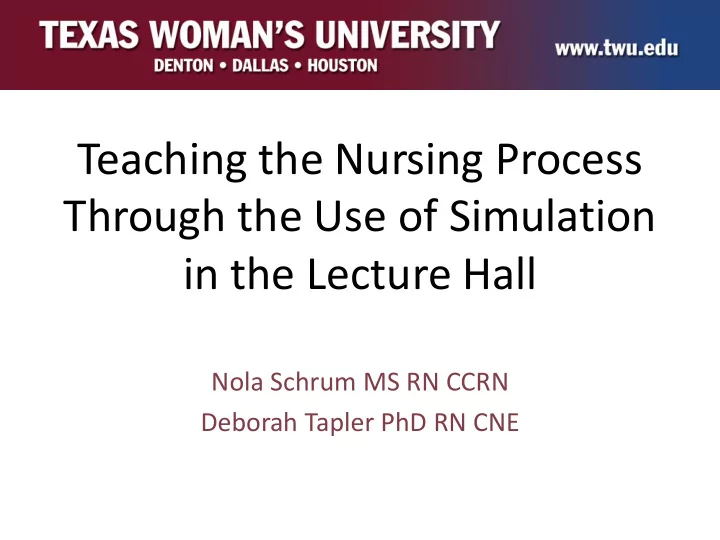

Teaching the Nursing Process Through the Use of Simulation in the Lecture Hall Nola Schrum MS RN CCRN Deborah Tapler PhD RN CNE
Teaching the Nursing Process • Difficult abstract concept to teach • Large number of students in the classroom • Didactic presentation of the elements using a computerized slide format
Lack of a Reference of Understanding • Introduced to junior students with no clinical experience or previous patient interaction • Fear and anxiety about the first patient encounter • Care plans poorly implement the nursing process
Innovative Educational Strategy Didactic classroom presentation + Simulation using a standardized patient
Teaching Plan • Computerized slide presentation – What is critical thinking? – Nursing process: assessment and diagnosis • Standardized patient brought into classroom – Scenario and patient history – Gown, urinary catheter, abdominal dressing, IV
Teaching Plan • Report given to oncoming nurse – Students record patient data from interaction • Nurse meets patient and performs shift assessment • Interactive exchange between nurse and patient
Observation by Students Role modeling • Communication • Assessment • Hands on interventions • Responding to the patient
Nurse and Standardized Patient
Teaching Plan • Assist the students to construct a basic concept map using the patient data from the interaction • Computerized slide presentation – Nursing process: planning, intervention, evaluation • Continue interaction with patient noting changes
Basic Nursing Care
Student Comments COMMENTS LEARNING OUTCOME “More interactive. I personally don’t enjoy PowerPoints.” Interactive, engaged “More real.” “Demonstration makes the concepts come to life – makes it real. I felt learning like I was Ms. Schrum, trying to figure out what to do with this patient.” “New way to learn.” “Not boring. “Interactive learning keeps me engaged.” “Makes the content fascinating.” “Better understanding of the concepts through active class participation.” “Demonstrations showed the evolving nature of the Nursing Process.” “Breaks down the lecturer - student barrier.” “Helpful to see concepts applied in front of you.” “Helps me better relate teaching to real life. Make information more interesting.” “It’s attention grabbing–increases focus on the subject.” “I was actively learning. I felt more engaged.” “Allows thinking with action versus thinking about PowerPoints.”
Student Comments COMMENTS LEARNING OUTCOME “ Demonstrates leading by example/visualization. Demonstrates Cognitive modeling process/action and systematic approach.” “Shows integration.” “Definitely easier to follow and apply. Hearing the rationale on top of seeing the demonstration was great.” “Helps student prepare better for clinical. How to interact with patients. Solve difficult problems that were given by the patient.” “Really helped me to understand the assessing process by seeing it in action.” “Visual demonstration is easier to remember. Student can put herself ‘in the instructor’s shoes’.” “It puts all the pieces of nursing care together.” “Show actual nursing process in practice—not abstract.” “Provides example and application of nursing process in the clinical setting.” “See how a seasoned nurse works.” “Puts the words into action.” “Provides a good model of quality patient care (emotionally and physically). Visualization is a great method of learning.” “Showed how to speak to patients.”
Student Comments COMMENTS LEARNING OUTCOME “Using a real patient was more helpful because her Active learning responses and physical cues were more realistic than a slide with standardized show or SIM model.” “Provides a REAL scenario.” patients “It gives you a realistic representation.” “Gives a realistic view and will help students remember things more effectively.” “It helps to see how to talk to the patient in a casual way.” “More room for variation/teach new things quickly.” “More personable, more human.” “Gives a real life example, not of just listening/reading.”
Student Comments COMMENTS LEARNING OUTCOME “Allows visual learners to process information.” Address diverse student “Reading and listening to the information then seeing it.” “More likely to remember the information since we saw it firsthand. learning styles Reinforces the steps and thought processes we need to have in the clinical setting.” “Good for visual learners.” “It helps visual/kinesthetic learners like myself.” “I partially learn from audible sounds –I will be able to recall the patient’s verbal pain responses as well as their responses to the nursing asking them things to do.” COMMENTS LEARNING OUTCOME “I received a sense of direction for my first clinical. Definitely decreases my Gain confidence and anxiety and makes me think I CAN DO IT.” “Alleviates anxiety about expectations of nursing students in clinicals .” competence “I don’t feel so anxious performing this myself.” “Shows you that it really is not so hard or difficult. Enables you to see what you will really be doing.” “Decreased anxiety about doing it in the hospital.” “Increases our knowledge of what to expect.” “Seeing our professors in real world scenarios eases anxiety.” “Gave confidence and eased nerves.”
Summary • Innovative teaching strategy bringing simulation and a standardized patient into the classroom • Dynamic approach that engages novice students when learning the abstract components of the nursing process • Allows students to envision their role in the clinical setting • Less fear and anxiety when anticipating the delivery of patient care for the first time • Active and experiential learning in the classroom
Questions Contact us at Texas Woman’s University, College of Nursing, Dallas, Texas – Ms. Nola Schrum, nschrum@twu.edu – Dr. Deborah Tapler, dtapler@twu.edu
Recommend
More recommend